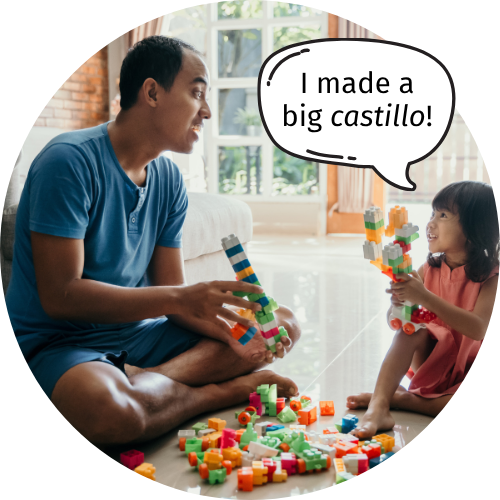Speaking More Than One Language with My Child
If your child seems to be delayed in learning to talk, you might be wondering if using more than one language is making things more difficult for them.
This is a natural question for a parent to ask. And you may have received different advice from others, making things even more confusing. Research shows that bilingual parents get lots of different advice. Some parents are told it is fine to use more than one language, while others are told to use only one language3!
So, which is true? Let’s explore what the research tells us about the most commonly asked questions about bilingualism.
What is bilingualism?
Bilingualism means learning more than one language and being able to understand and communicate in these languages. Depending on when a child learns their languages, they may be considered either a simultaneous bilingual or a sequential bilingual:
Simultaneous bilingual | Sequential bilingual |
|---|---|
The child learns two (or more) languages at the same time, from birth | The child learns a second language after their first language is established, often when they start school |
Does bilingualism cause language delays?
There is no evidence that being exposed to more than one language causes language difficulties or delays. Both children who are and are not bilingual can have language delays.
Can children with language difficulties or delays learn more than one language?
Yes, research has shown that children with language difficulties can learn more than one language, either simultaneously or sequentially2. Children with language difficulties should have the opportunity to be bilingual just like other children! What is most important is that children are involved in enjoyable back-and-forth interactions in both of their languages, so they have enough exposure to their languages to support their learning.

My child switches between their languages in conversation – is that okay?
Switching back and forth between languages in conversation, otherwise known as code-switching, is very common in bilingual speakers. On its own, switching between languages is not a sign of language difficulties5. Studies suggest that children pull words from one of their languages if they don’t know the word in the second language9. Code-switching just shows how children use all the tools they have to communicate as best they can, using both of their languages.
What are the benefits of bilingualism?
Being able to speak more than one language has many benefits.
Here are some:
- Bilinguals can interact with more people, using all of their languages
- Bilinguals are able to share traditions and connections with family members in their home languages
- Some studies suggest bilinguals are better at focusing on important information and ignoring unnecessary information8
How can I best support my bilingual child who has a language difficulty or delay?
If you are worried about your child’s communication, the most important step is to see a speech-language pathologist (SLP). The SLP will assess your child’s communication skills and provide recommendations for how you can support them.
You are the most important person in your child’s life and how you interact with your child in all the languages you speak is what makes the biggest impact on their communication skills. It is important to expose your child to their languages during enjoyable, back-and-forth interactions in a variety of situations. This means not just talking to your child but talking with them.
Here are some ways you can support your child’s communication:
- Speak to your child in the language you’re most comfortable using.
- Let your child start interactions, so you know what they want to communicate about. This means that you wait without talking, looking interested, so your child has a chance to communicate what’s on their mind.
- Interact with your child during everyday activities such as play time, bath time, mealtimes, or going for a walk.
- When your child communicates with you in any way – this may be by using a gesture (e.g. pointing, using the “sleep” gesture of head to the side and resting on their hands), making a sound or using words – respond right away by saying something related to their message. In other words, don’t change the subject! Stick with what they are interested in.
- Once you respond, give your child the time they need to respond. You may need to wait up to ten seconds.

If you’re interested in learning more about how you
can turn everyday interactions with your child into opportunities to build their communication, It Takes
Two to Talk® might be right for you! Learn more about the
It Takes Two to Talk Program for parents and It Takes Two
to Talk guidebook.
To sum it up…
Bilingualism is a gift! When you support your child to be involved in enjoyable interactions throughout the day in the language you know best, you are sharing your gift with your child.
Similar articles by tag:
It Takes Two To Talk | Language Development | Language Delay | Bilingualism | Dual Language Leaners
